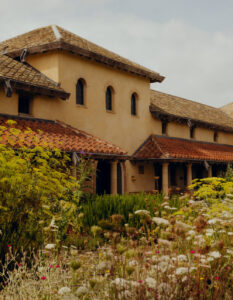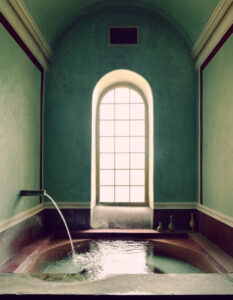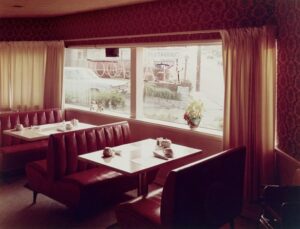


In the heart of Somerset, England, where green pastures roll into the horizon, an estate held secrets buried beneath centuries of soil. The year was 1832, and laborers working the land stumbled upon something extraordinary: fragments of history hidden in the ground. Without the expertise of an archaeologist, they turned to the local vicar, an amateur historian with a curiosity for the past. What he identified astounded them—a trove of Roman coins dating back to the reign of Emperor Constantius II in the 4th century, and remnants of what seemed to be a Roman villa. It was the first chapter in a story that would span nearly two centuries, culminating in a remarkable endeavor to bring the past to life.
A Dream Unearthed
For years, the site remained largely forgotten, its significance overshadowed by time. That changed in 2013, when South African couple Koos Bekker, a telecoms billionaire, and Karen Roos, former editor of Elle Decoration South Africa, purchased Hadspen House, an 18th-century Georgian estate. With their vision and seemingly boundless resources, they began transforming the estate into a multifaceted destination. What started as the conversion of the manor house into a luxurious hotel and spa evolved into something far greater.
The estate, renamed The Newt in Somerset after the small amphibians thriving in its ponds, became a living, breathing tribute to nature and heritage. Thirty acres of gardens were meticulously restored, agricultural outbuildings repurposed for accommodations and retail spaces, and hundreds of acres of farmland turned into a self-sustaining ecosystem producing cheese, cider, and clean energy. Cultural and educational programs flourished, with experts in biodiversity and regenerative farming leading workshops for members. Yet, amidst all this, one piece of the estate’s history remained tantalizingly unexplored—the Roman ruins.
The Great Excavation
In 2015, Bekker and Roos made the bold decision to unearth the site in earnest. They enlisted teams of archaeologists to conduct what would become Britain’s largest privately funded excavation. The scale and ambition of the project were unprecedented, attracting attention from archaeologists across the country. Among them was Ric Weeks, who would eventually become the Newt’s onsite archaeologist and exhibitions manager.
“This kind of site is common in Britain,” Weeks explained, “but the level of exploration here was extraordinary. The team had 18 months to delve deeply, allowing us to unravel the villa’s full chronology.”
The excavations revealed a story spanning centuries. Initially a modest three-room farmhouse built on the site of an Iron Age settlement, the villa evolved between the 3rd and 5th centuries as its owners’ fortunes grew. Additions such as a dining room and an elaborate bathhouse reflected the growing wealth of its inhabitants. By A.D. 350, the villa was a grand estate belonging to a noble of magisterial rank, akin to a modern-day multimillionaire. Among the most remarkable discoveries was a rare crossbow-shaped brooch—one of only seven known in the world—carefully placed as an offering beneath a floor.
Rebuilding History
The excavations offered a treasure trove of artifacts, including mosaics depicting Diana, the goddess of hunting, and Bacchus, the god of wine. But for Bekker, Roos, and their team, simply preserving the ruins was not enough. They wanted to bring the villa back to life, to create a space where visitors could step into the shoes of its Roman occupants.
After the dig concluded in 2016, discussions began about reconstructing the villa. It was an ambitious idea, one that required input from architects, historians, and the Southwest Heritage Trust. The decision was made to recreate the villa using the same materials and techniques the Romans would have employed. Honey-colored Hadspen stone and handmade terra-cotta tiles were sourced locally, and the villa’s T-shaped plan—180 feet wide and 70 feet long—was faithfully reproduced.
Villa Ventorum: A Vision Realized
The result was Villa Ventorum, a full-scale reconstruction of the Roman villa, unveiled in 2022. Located within sight of the original ruins, the villa appears as though it has always been part of the Somerset landscape, nestled among vineyards and rolling hills. Its design is as authentic as possible, with bedroom chambers, kitchens, and a working complex of Roman baths painstakingly rebuilt.
The villa’s exterior is surrounded by medicinal herb gardens, echoing the self-sufficiency of Roman estates. Inside, the rooms are furnished with replicas of Roman furniture and artifacts, creating an immersive experience for visitors. The baths, a centerpiece of Roman daily life, have been fully functional, allowing guests to experience the luxury and sophistication of ancient bathing rituals.
A Museum of Memories
Alongside the reconstructed villa, a modern glass-walled museum was built to house the artifacts unearthed during the excavation. The brooch, mosaics, and countless other items are displayed with detailed interpretations, offering insights into the lives of the villa’s inhabitants. Visitors can trace the evolution of the estate, from its humble beginnings as a farmhouse to its peak as a noble residence.
The museum also serves as a hub for education, hosting workshops and lectures led by archaeologists and historians. Through these programs, visitors gain a deeper appreciation for the ingenuity and resilience of Roman civilization.
A Living Legacy
The reconstruction of Villa Ventorum is more than a historical curiosity—it’s a testament to the vision of its creators and the enduring relevance of the past. By blending heritage with hospitality, the Newt in Somerset has redefined what it means to preserve history. Visitors can wander the villa’s halls, soak in its baths, and walk the vineyard paths, experiencing a world that existed over 1,500 years ago.
For Weeks and the team behind the project, the villa is a bridge between eras. “We’re not just preserving history,” Weeks says. “We’re bringing it to life in a way that’s tangible and meaningful.”
Culture and Education
Villa Ventorum and its accompanying museum have become key attractions at the Newt, drawing visitors from around the world. The project has elevated the estate beyond a luxury destination, transforming it into a cultural and educational hub. Through events, workshops, and immersive experiences, the Newt connects people with the region’s Roman past while fostering a deeper understanding of its legacy.
Challenges and Triumphs
Reconstructing the villa was not without its challenges. The team had to navigate the delicate balance between authenticity and modern practicality. While the goal was to use traditional materials and methods, certain adaptations were necessary to ensure structural stability and visitor safety.
Funding such an ambitious project was another hurdle, but Bekker and Roos’s commitment ensured that no detail was overlooked. Their investment has paid off, creating a lasting monument to Somerset’s rich history.
A Model for the Future
The success of Villa Ventorum has set a precedent for how archaeological sites can be integrated into modern developments. By combining preservation with innovation, the project demonstrates that history can be both educational and profitable. It serves as a model for other estates and institutions looking to make heritage accessible and engaging.
Impression
The story of Villa Ventorum is one of vision, perseverance, and a deep respect for history. From the laborers who unearthed the first coins in 1832 to the team that reconstructed the villa in 2022, every chapter of this tale speaks to the enduring allure of the past. Today, the villa stands as a testament to the ingenuity of the Romans and the ambition of those who brought their world back to life.
In the rolling hills of Somerset, where ancient history meets modern luxury, the Newt in Somerset continues to write its own story—one that bridges the gap between eras and invites us all to step into the timeless beauty of the Roman world.
No comments yet.








